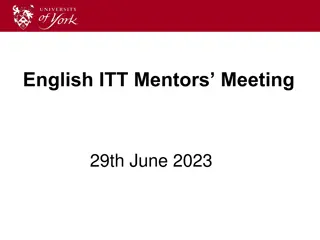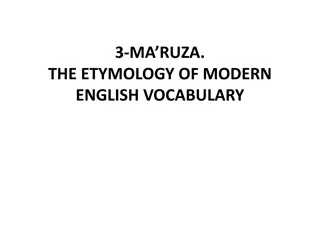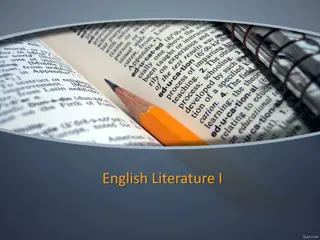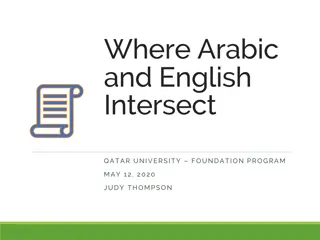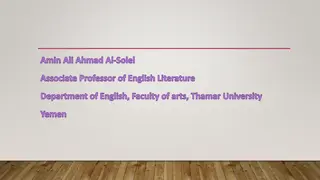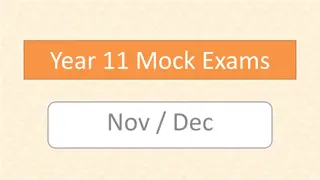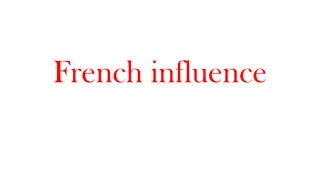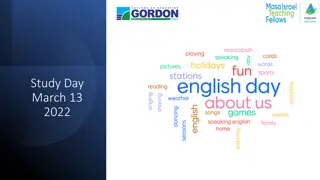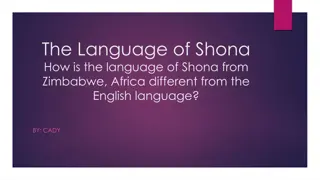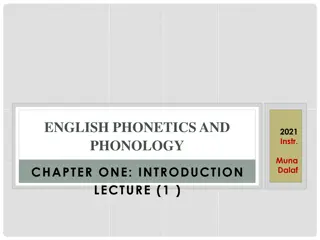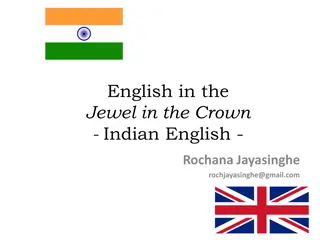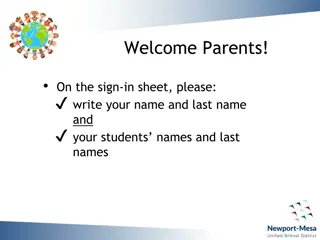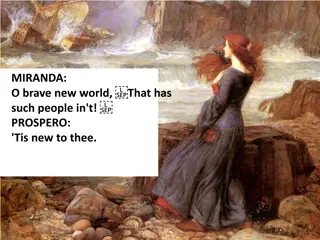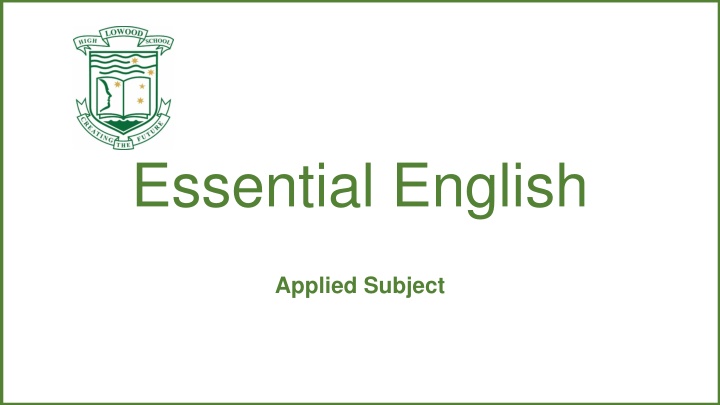
Explore Essential English Applied Subjects for Vocational Education
Discover the Essential and Applied Subjects program offering vocational pathways beyond secondary schooling, leading to vocational education, and work. Learn about the units and topics covered, including language, human experiences, popular culture texts, and more. Develop essential literacy, numeracy, and applied learning skills for future employment and education opportunities.
Download Presentation

Please find below an Image/Link to download the presentation.
The content on the website is provided AS IS for your information and personal use only. It may not be sold, licensed, or shared on other websites without obtaining consent from the author. If you encounter any issues during the download, it is possible that the publisher has removed the file from their server.
You are allowed to download the files provided on this website for personal or commercial use, subject to the condition that they are used lawfully. All files are the property of their respective owners.
The content on the website is provided AS IS for your information and personal use only. It may not be sold, licensed, or shared on other websites without obtaining consent from the author.
E N D
Presentation Transcript
Essential English Applied Subject
Essential and Applied Subjects Essential and Applied Subjects Applied subjects are suited to students who are primarily interested in pathways beyond senior secondary schooling that lead to vocational education and training or work. Results in Applied subjects contribute to the award of a QCE and one Applied subject result may contribute to an ATAR. At Lowood SHS we do not recommend students wishing to undertake an ATAR enter an Applied subject. Students will need solid foundational skills in literacy, numeracy, applied learning, community connections and core skills for work from which to work in an Applied subject.
Frequently Asked Questions Frequently Asked Questions Why are there pre-requisites to enter this subject? There is no pre-requisite for Essential English. This course uses the foundational skills learnt in P-10 to further develop skills required for future employment and study.
Frequently Asked Questions Frequently Asked Questions What are the Units and Topics studied in this subject? Unit 1 (Year 11) Language that works Texts and human experiences Unit 2 (Year 11) Unit 3 (Year 12) Language that influences Unit 4 (Year 12) Representations and popular culture texts OERVIEW: In Unit 4, students explore how the generic structures, language features and language of contemporary popular culture texts shape meaning. They revisit and build on learning from Units 1, 2 and 3 about how the relationship between context, purpose and audience creates meaning, and they independently apply comprehension strategies when engaging with texts. Students respond to and engage with a variety of texts, including Australian texts, and create texts of their own. In responding to popular contemporary texts, students consider how perspectives and values are represented dependent on audience, purpose and context. They reflect on a range of popular culture texts and develop their own interpretations. OVERVIEW: In Unit 1, students explore how meaning is communicated in contemporary texts developed for and used in a work context. Students develop and use a range of strategies and skills to comprehend and interpret these texts. They explore how the relationships between context, purpose and audience create meaning in work- related texts. Students identify, consider and explain language choices and the organisational features of texts, and their impact on meaning. Students respond to a variety of work-related texts and create texts of their own for a variety of purposes and audiences. OVERVIEW: In Unit 2, students explore individual and/or collective experiences and perspectives of the world. Students explore how different perspectives, ideas, cultural assumptions, attitudes, values and beliefs are communicated through the textual representations of a range of human experiences. They identify audience and purpose, and consider how meaning is shaped in reflective and nonfiction texts to invite audiences to accept a particular point of view. Students respond to a variety of reflective and/or nonfiction texts by creating texts of their own for a variety of purposes and audiences. OVERVIEW: In Unit 3, students explore community, local and/or global issues and ideas presented in a range of texts that invite an audience to take up positions. Building on Units 1 and 2, students apply their understanding about how perspectives, ideas, attitudes and values are represented in texts to influence audiences to take up positions. They explore how issues are represented in a range of texts and develop their own point of view about these issues. Students synthesise information to respond to and create a range of texts, considering their intended purpose, their representation of ideas and issues, and audience responses. In responding to texts, students have opportunities to discuss and listen to differing perspectives, compare, draw conclusions and influence audiences for a range of purposes. In responding to texts, students identify the different perspectives, ideas, cultural assumptions, attitudes, values and beliefs that have been communicated through the purposeful construction of identities, places, events and concepts. Students apply their knowledge and understanding of how meaning is communicated in reflective and nonfiction texts when responding to a studied text or texts. In responding to texts, students focus on developing strategies and skills to comprehend texts developed for and used in a work context. They consider the various ways in which these texts communicate information, ideas and perspectives. They do this by developing and applying skills to identify main ideas, and interpret, question and infer when reading, viewing and listening to a range of texts. Topic 1: Responding to popular culture texts Topic 1: Creating and shaping perspectives on community, local and global issues Topic 2: Creating representations of Australian identities, places, events and concepts Topic 2: Responding to texts that seek to influence
Frequently Asked Questions Frequently Asked Questions What texts do we study in this subject? Some of the texts you study are listed below. Year 11: The Happiest Refugee by Ahn Do Puberty Blues (television program) Year 12: Collection of songs and poetry from contemporary artists The Story of Tom Brennan by J. C Burke
Frequently Asked Questions Frequently Asked Questions What assessments do I have to complete in this subject? (Year 11) Unit 1 (Year 11) Language that works ASSESSMENT 1: Spoken Students will create a spoken/signed text that explores an issue or idea currently represented in a work context. The spoken/signed text will invite audiences to take up positions about this issue/idea through selected content, language and textual elements to express their viewpoints. Conditions: Spoken/signed presentation of 4 6 minutes Three weeks notice of task Other: may be supported by additional audio, visual or digital media, but the focus of this assignment is the spoken/signed element spoken/signed mode may be live or audio- or video-recorded individual task Unit 2 (Year 11) Texts and human experiences ASSESSMENT 3: Multimodal Presentation Students will construct a multimodal text responding to an Australian text or texts representing the human experience for a specified purpose and audience. They will consider the language features and structure of these texts and explain the ways in which texts make meaning, create representations and invite audiences to take up positions. To do this, students explore the relationship between context, audience and purpose of the text or texts that represent the human experience. Conditions: Multimodal presentation of 4 6 minutes per student Three weeks notice of task Other: must include a combination of at least two modes, one of which must be spoken/signed spoken/signed mode may be live or pre-recorded to suit the text type chosen, e.g. speech, website or vlog individual, pair or group task specified context, audience and purpose ASSESSMENT 4: Written Extended ASSESSMENT 2: Short Response Short response to seen stimulus Students will respond to representations of a community, local and/or global issue in a seen work context text by writing a response that identifies, considers and explains how the elements or components that make up the text/s shape meaning. Short response to unseen stimulus Students will respond to representations of an identity or identities, place, event or concept in an unseen work context text by writing a response that identifies, considers and explains how the elements or components that make up the text communicates ideas and information. Conditions: Time: 1 hours plus 15 minutes of planning time, delivered in one continuous session or 90 minutes allocated over no more than three consecutive sessions Length: 200 300 words per response (total of 400 600 words) One seen stimulus text and one unseen stimulus text Students will create a written text in which they invite a specified audience to take up a position about representations of an individual or group of people facing adversity. To do this, students explore other people s representation/s of identities, places, events and concepts in a text or texts representing an individual or group of people facing adversity. Students use this understanding to communicate their own interpretations through the representation of an individual or group of people facing adversity. . Conditions: Length: 500 800 words Four weeks notice of task
Frequently Asked Questions Frequently Asked Questions What assessments do I have to complete in this subject? (Year 12) Unit 3 (Year 12) Representations of Madness ASSESSMENT 1: Spoken Students will create a spoken/signed text that explores an issue or idea currently represented in the media or that the student is individually interested in. The spoken/signed text will invite audiences to take up positions about this issue through selected content, language and textual elements to express their viewpoints. Conditions: Spoken/signed presentation of 4 6 minutes Three weeks notice of task Other: may be supported by additional audio, visual or digital media, but the focus of this assignment is the spoken/signed element spoken/signed mode may be live or audio- or video-recorded individual task Unit 4 (Year 12) Welcome to the End ASSESSMENT 3: Multimodal Presentation Students will construct a multimodal text responding to a popular culture text or texts for a specified purpose and audience. They will consider the language features and structure of these texts and explain the ways in which texts make meaning, create representations and invite audiences to take up positions. To do this, students explore the relationship between context, audience and purpose of the popular culture text or texts. Conditions: Multimodal presentation of 4 6 minutes per student Three weeks notice of task Other: must include a combination of at least two modes, one of which must be spoken/signed spoken/signed mode may be live or pre-recorded to suit the text type chosen, e.g. speech, website or vlog individual, pair or group task specified context, audience and purpose ASSESSMENT 4: Written Extended Students will create a written text in which they invite a specified audience to take up a position about representations of an Australian social group. To do this, students explore other people s representation/s of Australian identities, places, events and concepts in a popular culture text or texts. Students use this understanding to communicate their own interpretations through the representation of an Australian social group. Conditions: Length: 500 800 words Four weeks notice of task ASSESSMENT 2: Short Response Short response to seen stimulus Students will respond to representations of a community, local and/or global issue in a seen media text by writing a response that identifies, considers and explains how the elements or components that make up the text/s shape meaning. Short response to unseen stimulus Students will respond to representations of an identity or identities, place, event or concept in an unseen media text by writing a response that identifies, considers and explains how the elements or components that make up the text communicates ideas and information. Conditions: Time: 1 hours plus 15 minutes of planning time, delivered in one continuous session or 90 minutes allocated over no more than three consecutive sessions Length: 200 300 words per response (total of 400 600 words) One seen stimulus text and one unseen stimulus text
Frequently Asked Questions Frequently Asked Questions Does this subject have an external exam and what is it worth? No. Essential English does not have an external exam. HOWEVER, it does have a Common Internal Assessment. This assessment is developed by the QCAA and marked internally by the school. The common internal assessment (CIA) in Essential English is common to all schools and administered under controlled conditions, appropriate to the context of the school. The CIA assists in strengthening reliability and validity in Essential English. The CIA models best assessment practice, which teachers can apply to other internal assessments, including the: application of assessment standards depth of treatment of subject matter.
Year 11 Text Samples Year 11 Text Samples
Year 12 Text Samples Year 12 Text Samples
Contact Details Contact Details If you require any further details about this course please feel free to contact: Subject area Teacher: Amber Blums amblu0@eq.edu.au Chris Savage csava35@eq.edu.au Laura McKay lxmck6@eq.edu.au Michael Bates mrbat0@eq.edu.au Emma Hayes ehaye40@eq.edu.au Head of Department:


